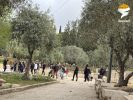Marj Sanur (Sanur Valley) south of Jenin city has lately turned into a lake with an aesthetic scenery covering thousands of dunums of land after a wave of heavy rains in the area.
As soon as the rough weather eased the Palestinian Ayman Zakarneh and his children headed to the lake for a picnic to enjoy the scene. Not only Zakarneh’s family but dozens of Palestinian families were there too for the same purpose.
Zakarneh and his family were looking for the missing water scene in their life in the West Bank which is geographically defined as a coastal strip extending along the Mediterranean Sea. However most of the West Bank Palestinians do not know this coast and have never been able to visit it because Israel’s Apartheid Wall has turned the territory into isolated cantons.
Sanur lake is now located on an area of 18000 dunums and surrounded by a mountain chain in the towns of Sanur Meithalun al-Judeida Siris Sir Misilyah and Jarba.
Palestinian farmer Mohammed al-Isa told the PIC reporter that the main reason for the rainwater accumulation in Marj Sanur is that it is surrounded by a mountain chain where there is no rainwater discharge systems.
“The lake appears in the years of high rainfall just like this year” he added.
The rainfall rate recorded in Jenin in 2019 exceeded 115% compared to an average year although winter is not over yet.
Negative impact on agriculture
As much as the sight of the lake generates happiness and pleasure among Jenin residents it is seen as a stumbling block by the farmers who have to wait until late summer to replant their lands.
All plans and projects set by the Ministry of Agriculture in collaboration with concerned organizations to solve the problem have failed because of the unprecedentedly large amounts of rainwater coming from all the nearby mountains.
Mohammed Habaiba also a farmer told the PIC reporter that Marj Sanur which is known for its fertile lands used to be planted with legumes cereals vegetables and other plants. “But this has been unavailable in recent years” he noted.
According to Habaiba 1992 witnessed the peak appearance of the lake as the rainfall in that year was three times the average rate.
After that the lake started to reappear once in every ten years depending on the rain season. Habaiba said that the lake is present in Palestinian folk stories in Jenin as a sign of the abundance of rainwater.






















